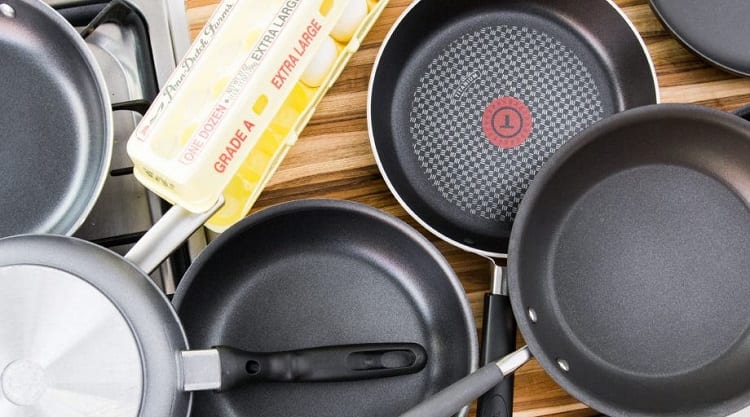Ceramic and Teflon cookware are both known for their nonstick coatings. When it comes to ceramic vs. Teflon cookware, which is best? That largely depends on your preferences. Ceramic is considered safer overall and is more nonstick, but Teflon is more affordable and the technology has been around longer.
Read on to find out more about these cookware coating to see which is best for you. We’ll go over the top questions and give you detailed answers.
Difference Between Ceramic and Teflon
Before going into which one is best, let’s first cover what these coatings actually are. First discovered in 1938, polytetrafluoroethylene or PTFE was created by Roy J. Plunkett for DuPont. Like many discoveries, this one was accidental and wasn’t meant to be nonstick.
The coating was supposed to make cookware more durable, but it didn’t take long for people to notice the nonstick benefits. It’s known as Teflon now because that was the original brand that used this coating.
Unfortunately, things weren’t all great with PTFE. It was discovered that toxic fumes were released when the cookware was heated above 500 F degrees. While this has certainly been reduced in modern times, it has left consumers wary of Teflon. Not only that, but the coating can chip if used harshly or with abrasive equipment.
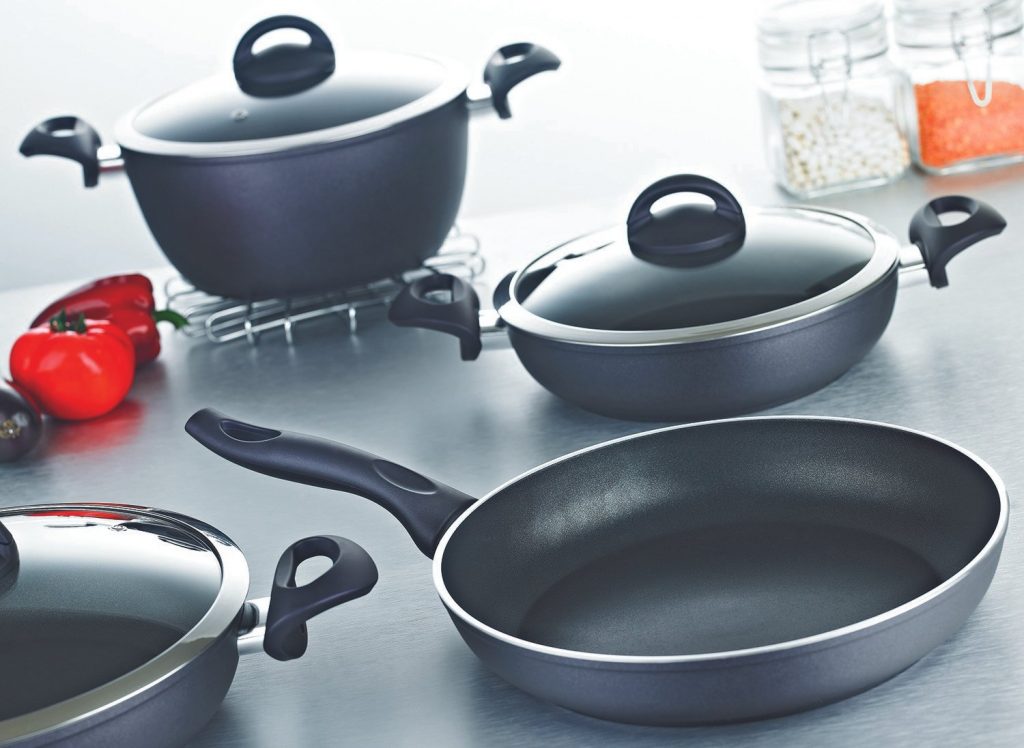
Ceramic has been around forever, but ceramic cookware is a fairly recent invention. This material is better known for making flower pots and bowls, not pots and pans. This coating is entirely water and oil resistant. It’s also so nonstick that you can cook an egg without any oil. Ceramic holds heat better than most materials and will continue cooking even when the burner is shut off.
Much like how Teflon is known for toxic fumes despite this problem being fixed, ceramic is still haunted by early mistakes. The first round of ceramic cookware had significant structural issues. It couldn’t be used in the dishwasher, and the ceramic chipped off fairly easily. This has been corrected by adding more layers of ceramic. Most modern ceramic pots and pans are now dishwasher safe.
Ceramic Cookware Pros and Cons
Ceramic cookware has a natural nonstick surface that requires little or no oil for easy cooking. This makes it easy to prepare traditionally sticky dishes, like eggs and meat. These pots and pans are also very simple to clean either by hand with a soft sponge and mild soap, or in the dishwasher (make sure the cookware is dishwasher safe first).
It also works well in high heats. Unlike Teflon, which can be dangerous at high heat, ceramic is perfectly fine.
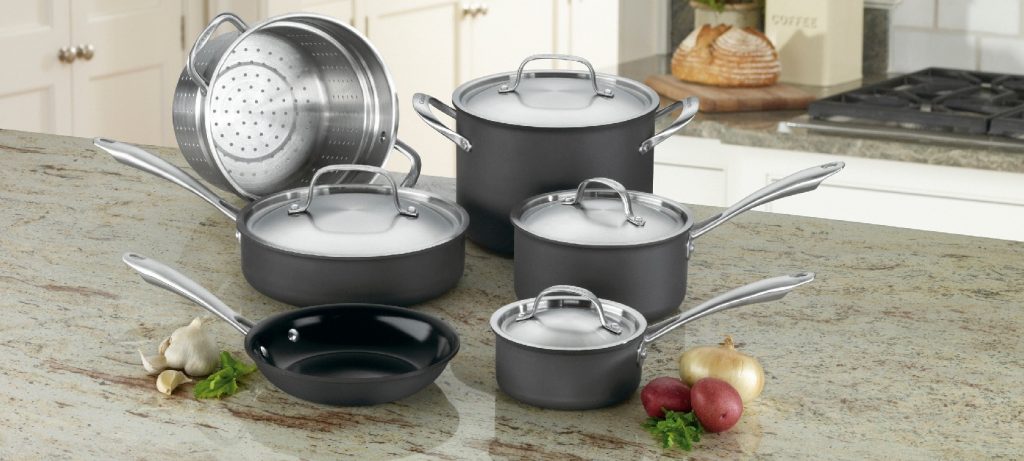
On the cons side, this is a newer material with less safety research than Teflon and other materials. While research currently shows ceramic as safe for cooking, it doesn’t have the decades of research like with Teflon.
There is also some concern about heat distribution. While ceramic itself holds onto heat very well and can even continue cooking after the burner is off, the surface is rough and there might be areas the food doesn’t touch. This could lead to somewhat inconsistent cooking, but this normally isn’t an issue.
What are the Pros and Cons of Teflon Cookware?
The biggest advantage Teflon cookware has is price. These pots and pans are inexpensive by comparison. If you’re careful and use the cookware right, then it should last just as long as ceramic. Another advantage is that they’re lightweight. Ceramic can be quite heavy.
This is a highly effective nonstick coating and you should only need a tiny bit of oil for cooking. Not only that, but cleaning up is easy with mild soap and a soft sponge. Some Teflon can be placed in the oven, but make sure you check this first. Even if it can, you normally can only leave the pots and pans in there for 60 minutes at most and you must be careful about the temperature.
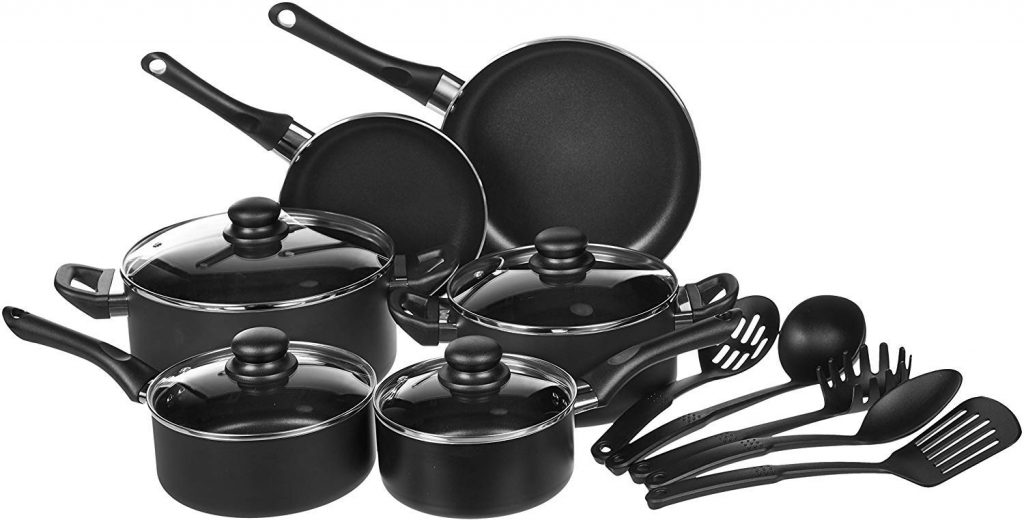
On the cons side, the coating is more likely to fall off than ceramic if you are rough with the cookware. This includes cooking at high temperatures, using sharp or metal utensils on the cookware, or using abrasive cleaning equipment.
There are also concerns about safety if the cookware is used at high temperatures, which we will cover later. Teflon cookware can also warp due to thermal shock, or introducing something very hot to a cold pan.
Ceramic vs. Teflon Durability
What do we mean by durability in this case? We are referring to how hard the cookware is, how well it can take damage, and how well it can resist high heats. Ceramic is the better of the two. This coating is thicker and leaves the cookware with a harder finish. It also has an easier time resisting high heats while Teflon is best for low to medium temperatures.
That being said, Teflon isn’t that far behind. If you’re only cooking standard meals and don’t need the heat to be super high for searing or blackening, then you may not even notice the difference. It only becomes apparent when you push this cookware to its limit.

It’s also important to note that this durability is all thanks to their coatings. The coating will thin and chip off eventually, so the durability will be lost once the coating is gone.
How Long Do Ceramic and Teflon Pans Last?
Despite ceramic being more durable, both coatings last about 3-5 years. This depends on the quality of your cookware and how you care for them. Teflon is somewhat more susceptible to damage.
If you use high heats and abrasive equipment, then the cookware might only last 6 months. Ceramic cookware tends to last longer under punishing circumstances, but it’s best to gently use pots and pans for the best longevity.
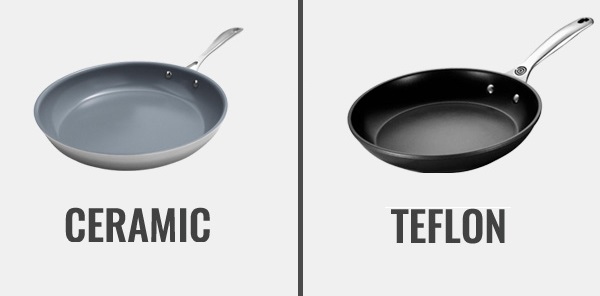
If you’re kind to your cookware, then you can expect the full 3-5 years. Consider replacing your pots and pans if they look discolored, warped, or if the coating comes off. Some people get even more time from their cookware, but you should look into replacements after the 5-year mark.
Do Ceramic and Teflon Pans Peel?
When it comes to ceramic vs. Teflon cookware, you’ll find that the nonstick coating will come off after several years of use. This is normally why you have to replace them. That being said, how the coating comes off is a little different for each.
Teflon coatings are more likely to peel and flake off. This happens if the pot or pan is at a high heat or if you’re using metal utensils. Not only will the cookware no longer be nonstick, but this can be dangerous if the coating gets in your food and you ingest it.
That’s not to say that accidentally ingesting ceramic isn’t dangerous, because it is. Ceramic coatings are more durable and are less likely to chip, but it can happen if the cookware is used improperly. Unlike Teflon, ceramic is more likely to chip or deteriorate than peel or flake.
This might seem like a small difference, but it makes the coating much less likely to end up in your food. Overall, both coatings will come off eventually. Ceramic tends to come off in a safer way, but eventually the coating will disappear and the cookware should be replaced.

Using the cookware safely will reduce the odds of the coating coming off. There are safety tips for both Teflon and ceramic. Try to stay within the recommended temperature range with both types of cookware. Teflon is best for low to medium temperatures while ceramic can take higher heats. Even still, using ceramic in extremely high temperatures isn’t a good idea and will damage the cookware.
Use the right utensils. Ceramic coatings often have an easier time with metal utensils, but it’s best to stick with softer materials like plastic. You also never want to use a knife or anything sharp on the pot or pan itself. This might seem obvious, but there are times where you might want to cut something in the pan and a knife seems smart. Just don’t do it.
Be careful when cleaning. If you have a dishwasher, then make sure the cookware is dishwasher safe. Most Teflon is fine for dishwashers, but older and low-quality ceramic cookware might have an issue with this. If you’re washing by hand, then don’t use an abrasive sponge or anything too harsh as this can take the coating right off. Just be safe and the coating should last a long time.
Is Ceramic Nonstick Safer Than Teflon?
If you’re using the pots and pans at very high temperatures, then definitely. Ceramic would be the safer choice then. However, things get less distinct as we dive deeper. In most cases you’ll find that both materials are safe for cooking, but it all depends on how you use it.
Let’s address the elephant in the room and bring up toxic fumes. You can’t search up Teflon cookware without toxic warnings coming up, and it’s only fair that we address this directly. The unfortunate truth is that Teflon is known to break down under high temperatures, usually 500 F degrees, and releases a host of toxic fumes into the air.
While most people are worried about the Teflon coating chipping and getting in their food, research shows that inhaling the fumes is even worse. Ceramic doesn’t have this issue at all. While the coating might deteriorate at extremely high heats, you’ll never have to worry about toxic fumes with ceramic. While the toxic fumes have been reduced throughout the years, this is still an issue.
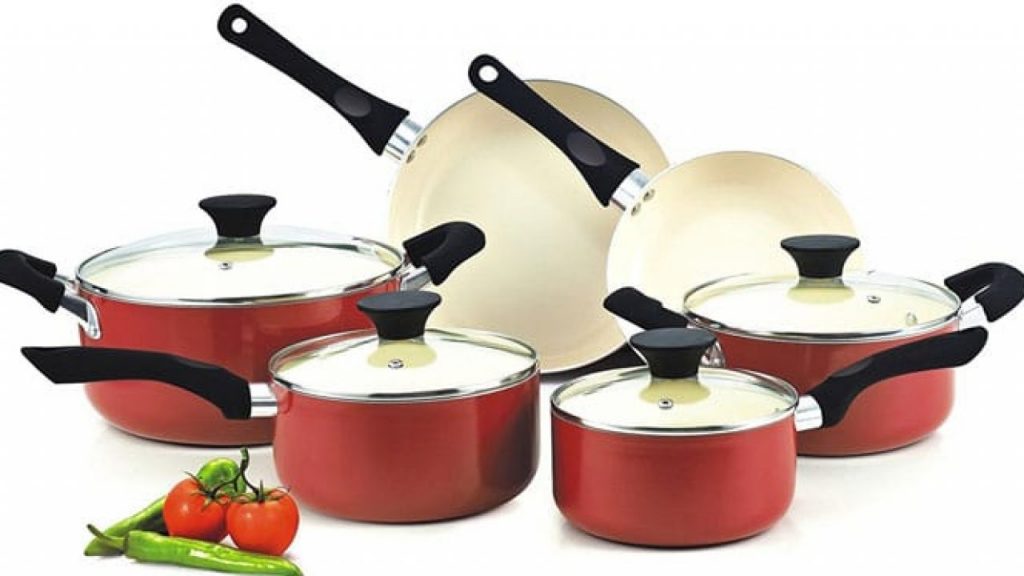
However, if you cook at low or medium temperatures, then this won’t be an issue. The fumes only appear at high temperatures as the Teflon is breaking down. If you’re cautious about the temperature, then Teflon should be safe.
Another thing you’ll want to consider is the durability of the coating. If you have older pans, then the Teflon coating might actually be more durable and less likely to come off than ceramic. Older ceramic coatings were shockingly easy to remove.
They would only last for a short time or would disappear completely in the dishwasher. This isn’t the case now, but you’ll want to be careful with the first generation of ceramic cookware.
Which Nonstick Cookware is Best?
We’re going to answer this from a perspective of which cookware is more nonstick than the other. In the next section we’ll cover which cookware is better overall depending on your needs. In terms of ceramic vs. Teflon cookware, both are very well known as nonstick coatings. Unlike stainless steel that loves to make eggs, burgers, and chicken sticks, both of these allow you to cook with ease.
Teflon requires very little oil even for traditionally sticky meals. A tiny splash of oil is all you need for eggs or chicken breast. You also don’t need to preheat the pan, unlike with stainless steel, in order to prevent sticking. Many people consider this the ideal cookware for beginners because it’s difficult to make anything stick.

While Teflon is great even when cooking with little oil, ceramic cookware is even more nonstick. You can cook an egg with literally no oil and it won’t stick. While oil will still be useful for encouraging browning and to help lube the pan, you can use even less and never have your food stick.
Both are great, but ceramic is a little better.
Is Ceramic Better Than Teflon?
This is a popular question, but it’s hard to answer. It depends on how you define “better.” You may have noticed that ceramic cookware ranks better in most categories. It’s more durable, better at nonstick cooking, less likely to peel, and usually lasts somewhat longer than Teflon. All of that would suggest that ceramic is better, but Teflon does have a few benefits.
Teflon is more affordable. It’s nearly as good as ceramic, but significantly more affordable. The coating has also been around for longer. This has given scientists more time to improve upon safety, dishwasher usage, durability, and more. Ceramic coatings are fairly new by comparison.

Ceramic is better in most ways, but it can’t compete on price. If budget is your main concern and you want nonstick cookware, then Teflon might be better for you.
Final Thoughts
So, who wins when it comes to ceramic vs. Teflon cookware? It depends on your perspective. If you want more affordable cookware and only intend on cooking at medium temperatures, then Teflon is probably better. It’s nearly as good in most ways, and the lower price tag is attractive.
If you don’t mind spending a little more, then ceramic cookware might be better. It’s more nonstick, safer, more durable, and ideal for high-heat cooking. Both are good, so it really depends on your priorities and how you prefer to cook.

